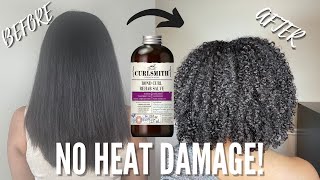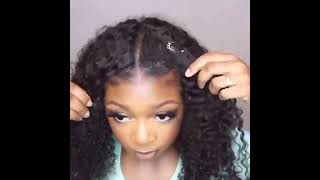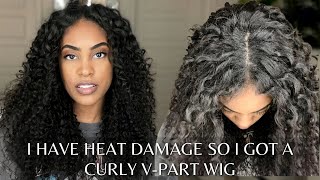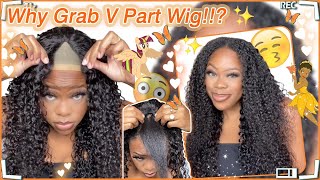So What If She Has Heat Damage? 4 Reasons You Shouldn’t Worry About Someone With Heat Dama

Do you know there are women out there who have made a conscious decision to live with heat damage? Why is it that when a woman decides to embrace and love her relaxed hair, we generally have a bit more understanding but when a woman chooses to live with heat damage there might be shade?
We tend to have a curl pattern obsession these days, like spirals and Z’s are the end all and be all. Before I go any further, this will seem as if I condone heat damage, but the truth is there is nothing to condone or disapprove of when it isn’t my hair that’s on trial. The point I am trying to make is that you do not have any right to tell another person what to do with her hair even if some of it is straight and some of it isn’t.
The other day there was a young lady that posted in a hair forum about feeling less than confident about her hair because she has heat damage and her online friends made no apologies about dismissing her pictures and comments because of it.
She wanted everyone to know once and for all that she did not think that those kind of comments were right and she wanted to feel good about her hair even with heat damage. You see she knows she will straighten her hair because it is easier for her, so why should she feel bad about it?
It got me thinking when is having heat damage ok in a practical sense? To answer that question we have to identify what damage is because that word is used pretty loosely and has a pretty negative connotation attached to it.
What is damage as it relates to hair
Your hair strands are held together by chemical bonds called disulfide bonds and hydrogen bonds. The bonds give your hair strands their shape or that curl pattern you love so much. Hydrogen bonds can be altered when wet, so if you want a banging Twist Out, start out with wet hair and allow the twists to dry and take shape. Even though you do not think you are doing anything to your strand when you style it in that manner, you actually are changing its structure albeit temporarily.
If you finally get that banging Twist Out and you go outside and it happens to be humid you will notice your hair taking on another shape, the infamous poof! Again these are the hydrogen bonds in your hair reacting to the moisture in the air. For us hydrogen bond change is cool, we don’t consider it a problem or something to look down on, but you could still technically call it ‘damage’.
When you perm or relax your hair you break the disulfide bonds permanently to achieve the look. Your strand is stripped of the proteins that you need to give your hair some curl pattern. The strand is thinned out and the only way to give it strength is to add protein to your regimen. The protein adds to the strand but not enough to ever bring your curl pattern back.
If you want curly hair again, you will have to stop relaxing and allow your natural hair to grow out. Relaxing is considered ‘damage’ but it is a personal choice that depends on your hair goals and lifestyle so in most circles is quite acceptable.
 What about heat damage?
What about heat damage?
Heat from irons and other tools affect the hydrogen bonds we talked about earlier and as we mentioned, when you alter the hydrogen bonds it isn’t permanent. The tricky thing about heat is, you can not only break hydrogen bonds in the hair but if the heat is high enough, you can break disulfide bonds as well making your hair permanently straight much like a relaxer would. Yet this kind of damage but in most circles not acceptable.
The thing is, damage is damage, no matter how you slice it; color, heat, hygral fatigue or relaxers can all alter the structure of the strand and so there is no reason why a woman should feel bullied because she has heat damage and has chosen to live with it.
4 Reasons you should not criticize someone with heat damage
1. It’s not your hair
If she likes it, then you need to tip your hat to her and keep it moving it. It’s that simple – we are way too caught up in what other women are doing with their hair, especially when we do not fully understand that there is really nothing to turn up about.
2. Heat damage is not a deal breaker for her
For some, single strand knots, and split ends are a game changer but a few straight hairs are not. There is no way to really tell someone what they should or should not accept from their own hair.
3. Damage is damage
If you have color, we can say technically your hair is damaged too, but you wouldn’t want anyone to demand that you cut your hair, especially if it isn’t breaking or split. If you get it wet too often and it weakens because of hygral fatigue, it is damaged too, but again if it doesn’t bother you, it shouldn’t bother anyone else.
4. Some women like straight hair
If you routinely flat iron* your hair then more than likely you will get some heat damage. If you know you flat iron* weekly then you should expect that your hair will eventually conform (heat training). Is that bad? nope, it’s all relative love.
The point is, we all have various things that we like to do with our hair, heat styling or training might be one of them. What is most important is that you are still making progress on your own hair goals and on your own terms.
Now, don’t read this and then go around telling everyone that BHI said you can go out and get you some heat damage! You have to be sensible and know when to pull the plug on that flat iron* and blow dryer*, just like you would a relaxer.
If your hair is thinning and falling out, obviously you are doing more damage than justice. You have to know that for yourself because I just spent an entire post telling people not to say anything to you about your heat damaged hair!




